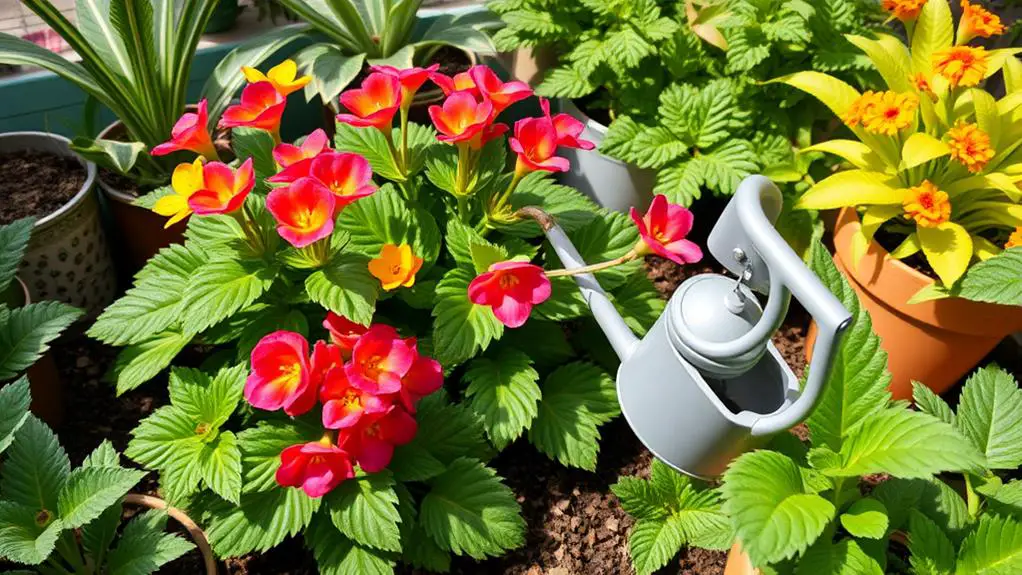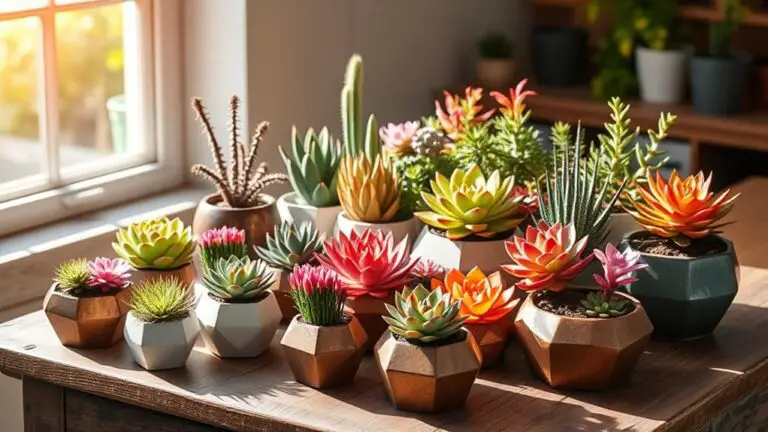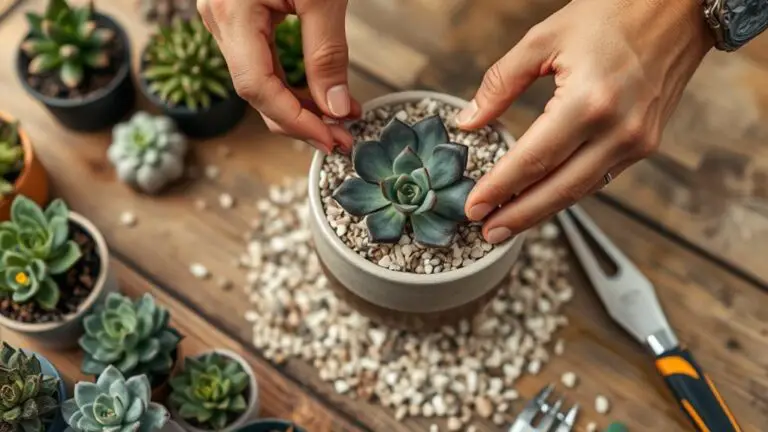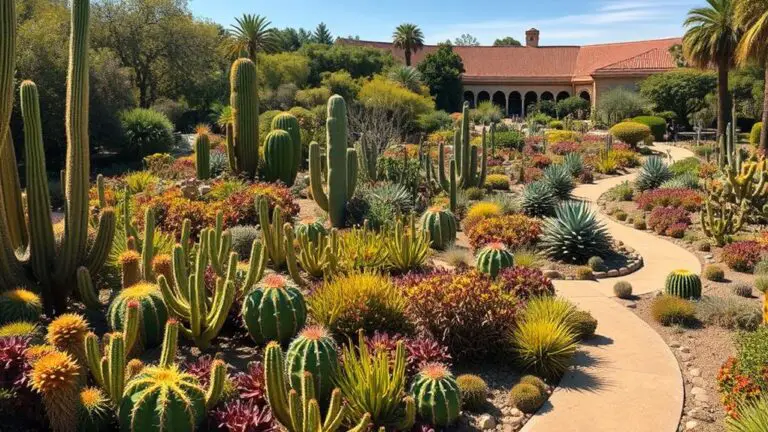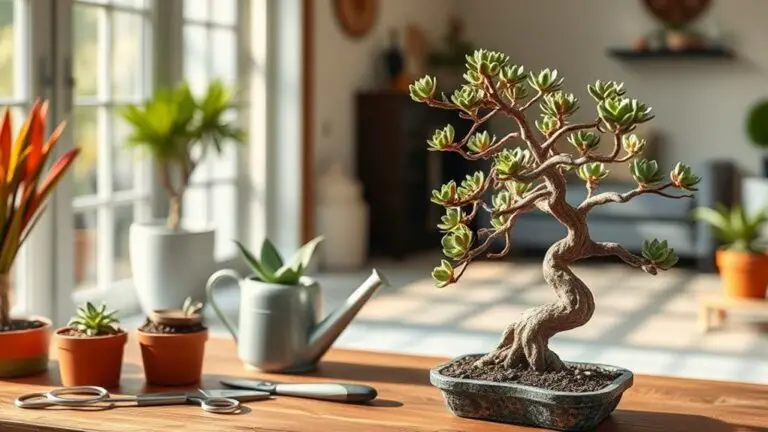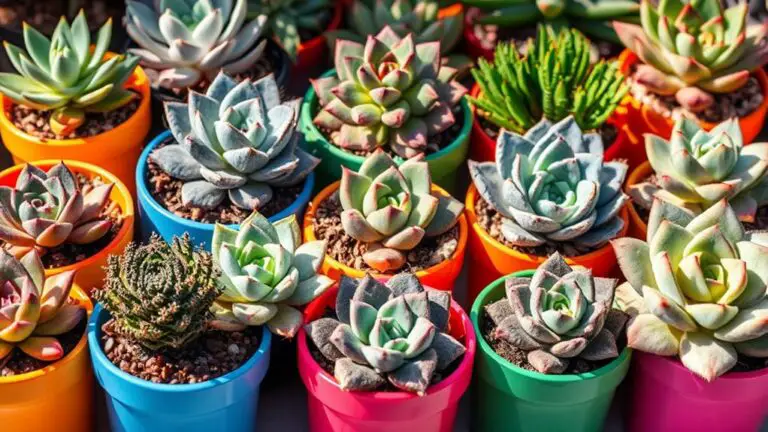7 Essential Steps for Growing Healthy Kalanchoe Plants
If you want your Kalanchoe plants to thrive, it's vital to follow seven key steps. Start by choosing a bright spot where your plant can soak up 6-8 hours of sunlight each day. Next, prepare well-draining soil, preferably a cactus mix, and use a pot with drainage holes. Water every 1-2 weeks, letting the soil dry out completely between sessions, and fertilize monthly during the growing season. Regular pruning will encourage blooming, and don't forget to manage pests and diseases. To guarantee your Kalanchoe blooms beautifully, proper light and fertilization techniques are essential. Want to know more specifics on each step?
Choosing the Right Location
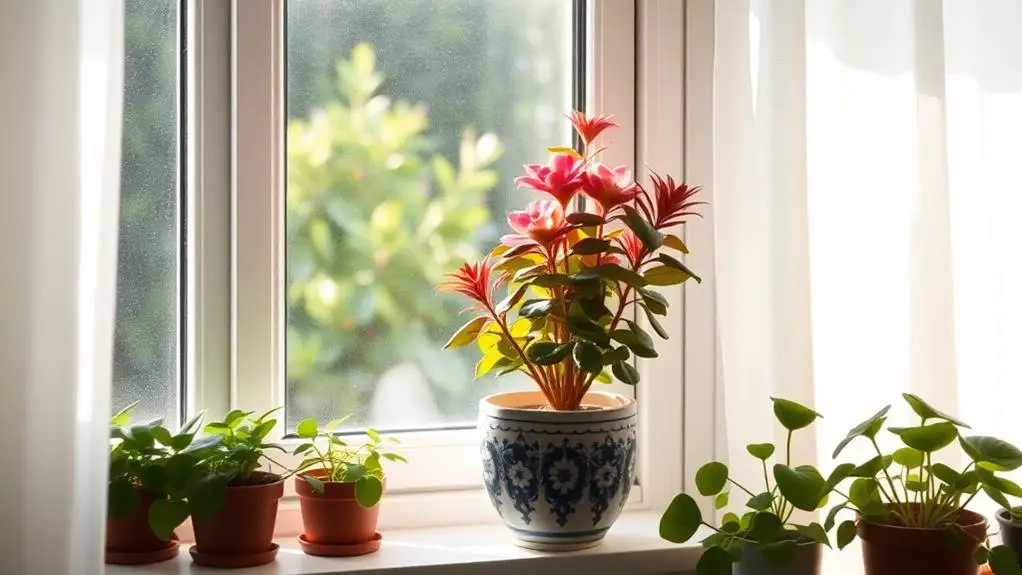
Choosing the right location for your kalanchoe plants is crucial to their health and growth. These vibrant indoor plants thrive in bright light, needing 6-8 hours of full sun to partial shade each day. If you're growing kalanchoe indoors, place them on windowsills that face south or west, as these spots provide the most consistent sunlight.
Be certain to avoid cold drafts from windows and doors, which can harm your plants.
When it comes to outdoor kalanchoe, temperature plays a key role. These plants aren't frost-tolerant, so you should bring them inside when temperatures drop below 55°F (13°C). During summer, make certain nighttime temperatures stay above 65°F (18°C) for the best growth.
Proper drainage is essential for kalanchoe. Choose a location that promotes well-draining soil to prevent water from accumulating and causing root rot. This step is crucial for both indoor and outdoor plants.
Setting your kalanchoe in the right location not only helps them flourish but also makes their overall care easier. Remember, selecting the perfect spot sets the stage for successful soil preparation and ongoing plant health.
Preparing the Soil
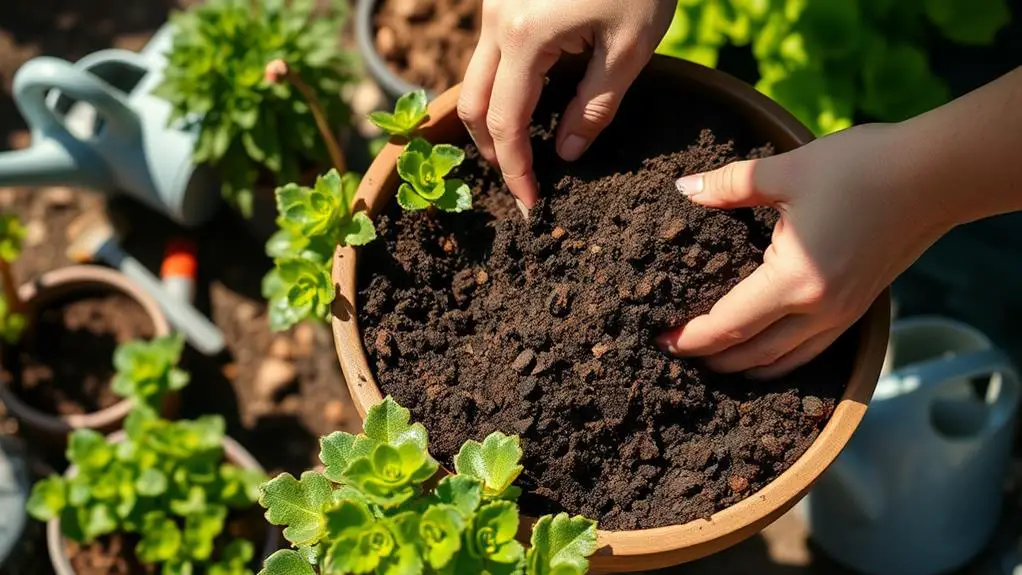
After finding the perfect spot for your kalanchoe, it's time to focus on preparing the soil. Kalanchoe thrives in well-draining soil, so using a cactus mix or a blend of potting soil, sand, and perlite is ideal to prevent root rot. Aim for a soil pH between 6.0 and 7.0, which is slightly acidic to neutral, to support peak growth.
Before you start, verify your pot has drainage holes to allow excess moisture to escape. This step is vital because it helps avoid water accumulation that can harm the roots. To enhance drainage even further, you can mix in materials like gravel or extra perlite. This guarantees the soil stays aerated and supports healthy growth.
Here's a quick guide to the best soil mix for Kalanchoe:
| Component | Purpose |
|---|---|
| Cactus Mix | Base for well-draining soil |
| Potting Soil | Provides nutrients |
| Sand | Improves drainage |
| Perlite | Enhances aeration and drainage |
| Gravel | Prevents moisture build-up |
Planting Kalanchoe
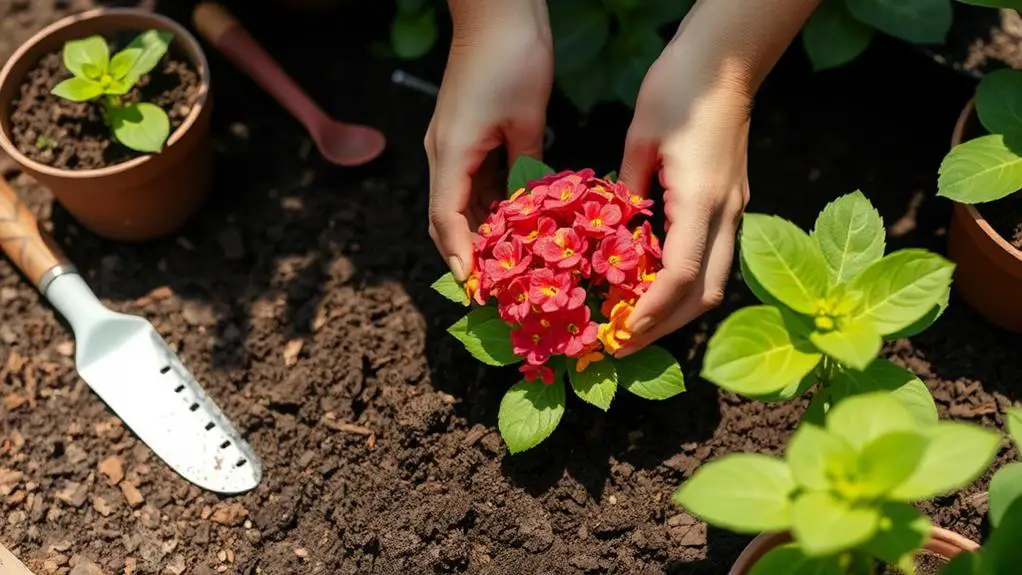
When planting your Kalanchoe, start by choosing a pot that's 2 inches wider than the root ball and has drainage holes to prevent water from accumulating.
Use a well-draining soil mix, like cactus or succulent potting mix, to keep your plant's roots healthy.
Plant the Kalanchoe at the same depth it was in its nursery pot, making sure the root ball is about an inch below the pot rim for easy watering.
Choosing the Right Pot
To guarantee your Kalanchoe thrives, you need to start with the right pot, which is vital for its growth and health. First, choose a pot that's at least 2 inches wider than the plant's root ball. This extra space will allow your Kalanchoe to grow and its roots to expand comfortably.
Make sure the pot has drainage holes at the bottom. These holes are essential for preventing water accumulation, which can lead to root rot. Opt for clay pots instead of plastic ones, as they absorb excess moisture and promote better drainage. This helps keep the soil from becoming too soggy.
Next, fill the pot with a well-draining soil mix. A combination of potting soil and cactus mix works best. This mixture guarantees that your Kalanchoe has the right environment for healthy root development.
When placing the root ball in the pot, position it about 1 inch below the rim. This setup leaves enough space for watering without causing overflow.
Preparing the Soil Mix
Now that you've selected the right pot, it's time to focus on preparing the soil mix for your Kalanchoe. Kalanchoe plants thrive in a porous potting mix, so you'll want to use a cactus or succulent mix to guarantee well-draining soil. This helps prevent root rot caused by excess moisture. Aim for a soil pH between 6.0 and 7.0, which is slightly acidic to neutral, for ideal growth.
To further enhance drainage and aeration, incorporate materials like perlite or gravel into the mix. This step is essential for maintaining healthy root structures and avoiding waterlogging. When you're ready for planting, position the Kalanchoe root ball about 1 inch below the pot rim. This allows space for watering without causing overflow.
| Material | Purpose |
|---|---|
| Cactus/Succulent Mix | Guarantees well-draining soil |
| Perlite/Gravel | Enhances drainage and aeration |
| Slightly Acidic pH (6.0-7.0) | Ideal growth conditions |
After planting, lightly water the Kalanchoe to settle the soil and establish root contact. This guarantees proper hydration without waterlogging. By following these steps, you'll provide the perfect environment for your Kalanchoe plants to thrive.
Planting and Spacing Tips
Planting your Kalanchoe correctly is essential for its long-term health and vibrant growth. Start by choosing a pot that's 2 inches wider than the root ball. Make certain it has drainage holes to prevent water accumulation, which can lead to root rot.
For potting, use a well-draining soil mix. A combination of regular potting soil and cactus mix works best to guarantee proper drainage.
When you place your Kalanchoe in the pot, position it at the same depth as it was in the nursery pot. This helps the plant adjust better. Fill in around the base with soil, patting gently for stability.
If you're planting multiple Kalanchoe plants in a garden bed, space them at least 6-12 inches apart. This spacing promotes good air circulation and prevents overcrowding, which can lead to diseases.
After planting, water lightly. You want the moisture to reach the root zone without making the soil soggy.
Watering and Fertilizing
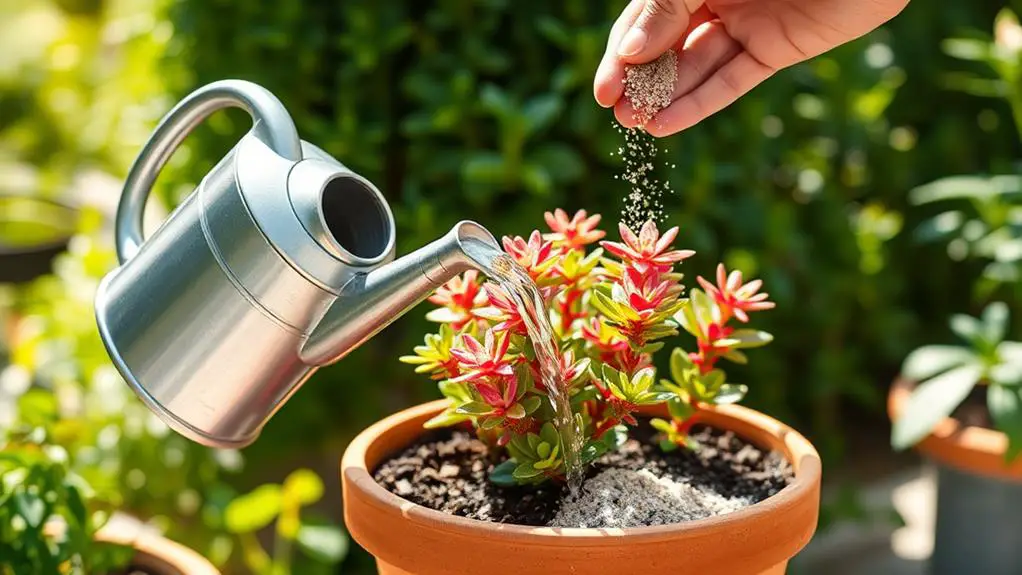
When it comes to watering and fertilizing your Kalanchoe, guaranteeing the right balance is key to maintaining a healthy plant. You should water your Kalanchoe every 1-2 weeks, allowing the soil to dry out completely between sessions. This helps prevent root rot, a common issue caused by too much moisture.
Check the soil moisture by inserting your finger about 2 inches deep; only water when the top layer feels dry to the touch.
During the growing season in spring and summer, fertilize your Kalanchoe once a month with a balanced, water-soluble fertilizer. This promotes vibrant blooms and healthy growth.
Be cautious not to overfertilize, as it can lead to leaf burn and other problems. If you notice any signs of overfertilization, adjust your schedule based on the plant's health and response.
As winter approaches and growth slows, reduce your watering frequency. Guarantee the soil dries out thoroughly between waterings to avoid overwatering.
Pruning and Maintenance
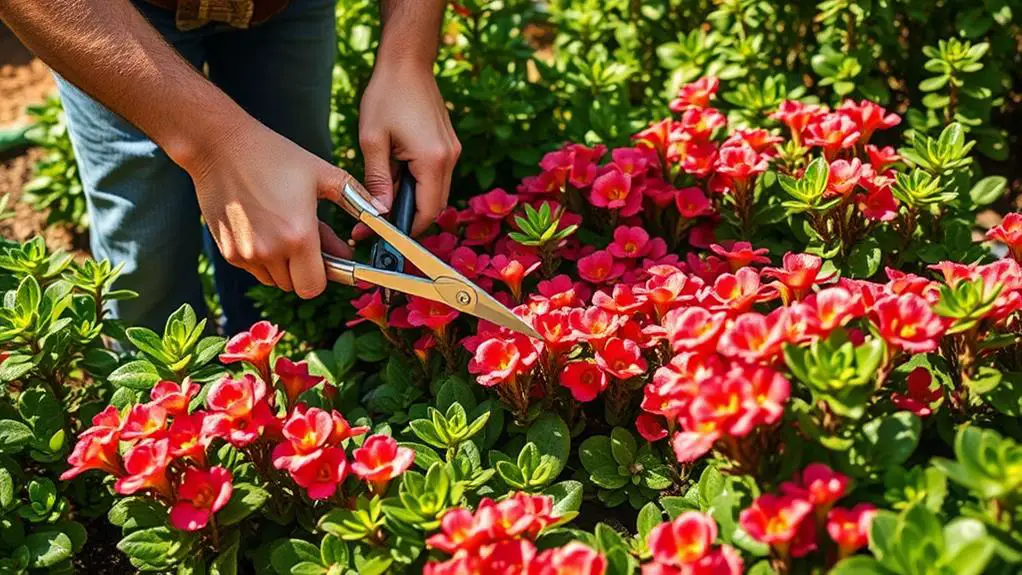
To keep your Kalanchoe plants looking great and blooming beautifully, regular pruning and maintenance are key.
Start by deadheading faded flowers to make way for fresh blooms, and pinch back stems in the spring to encourage a fuller shape.
Don't forget to check for any leggy growth, which might mean your plant needs more light, and trim those stems to help it grow denser foliage.
Deadheading for Reblooms
Deadheading your Kalanchoe plants is essential for encouraging reblooms and maintaining a tidy appearance. To start, you'll need to remove spent flowers as soon as they fade. This process, called deadheading, helps promote new blooms by redirecting the plant's energy from seed production to healthy growth.
To deadhead effectively, use clean scissors or pruning shears. Make certain they're sharp to prevent damage to the plant.
Regular deadheading can extend the blooming period, allowing your Kalanchoe to produce flowers multiple times throughout the year. When you prune Kalanchoe, cut back stems just above the first set of healthy leaves. This stimulates growth and encourages branching, which results in a fuller, more vibrant plant.
Shape and Size Control**
While deadheading keeps your Kalanchoe blooming, shape and size control through regular pruning and maintenance are equally important for a healthy, attractive plant. Regular pruning, especially in spring, helps maintain a bushy shape and encourages new blooms. By removing spent flowers and excessive foliage, you're giving your Kalanchoe a fresh start.
Pinching back stems is another great way to promote compact growth. It prevents your plant from looking leggy and keeps it full and vibrant. When you monitor your Kalanchoe closely, you can trim back any overly long or unruly stems to maintain the desired size and shape.
Repotting every 1-2 years is also essential. This process refreshes the soil, giving your Kalanchoe the nutrients it needs for healthier growth. It can also help in size control, ensuring your plant doesn't outgrow its space.
Don't forget about deadheading. By removing wilted flowers, you enhance your plant's appearance and stimulate further flowering. This keeps your Kalanchoe looking neat and encourages more blooms.
Managing Pests and Diseases
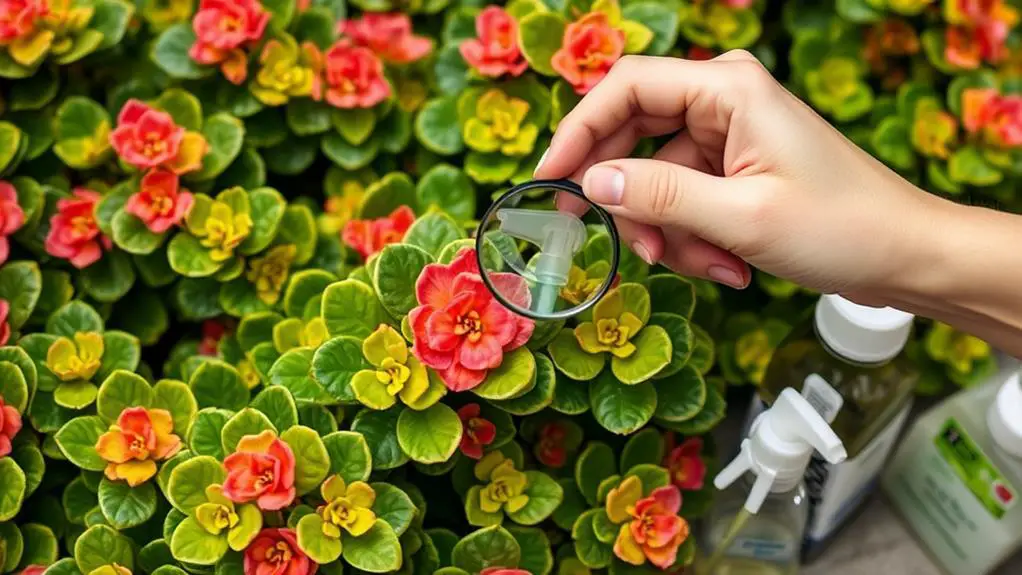
Keeping your Kalanchoe plants healthy means staying vigilant about potential pests and diseases. Regularly inspect your plants for common pests like aphids, mealybugs, and spider mites. These tiny invaders can cause significant damage if left unchecked. If you spot any pests, you should treat the infestation promptly. Use insecticidal soap or neem oil, making sure to cover both the upper and lower leaf surfaces for the best results.
Diseases can also pose a threat to your Kalanchoe plants. Watch for signs like yellowing leaves or mushy stems, which may indicate overwatering and root rot. Adjust your watering practices to avoid these issues. Overwatering is a common mistake that can lead to root rot, so be careful not to drown your plants.
Maintaining a clean growing environment is essential. Remove dead leaves and debris around your plants to minimize the risk of pests and diseases developing.
Additionally, encourage adequate airflow by spacing your plants properly and avoiding overcrowding. Good airflow helps prevent fungal issues and the spread of disease.
Encouraging Blooming
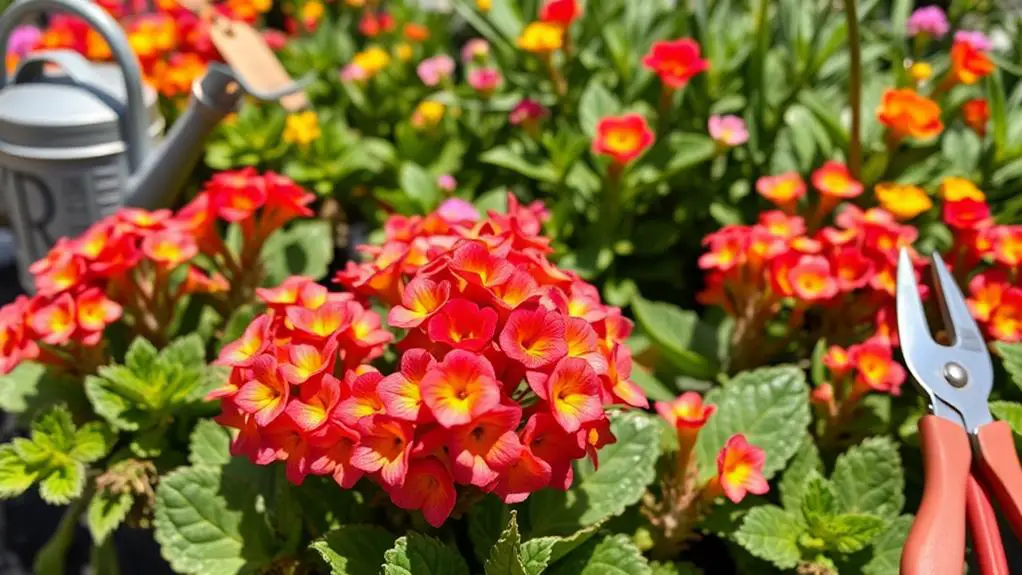
Getting your Kalanchoe plants to bloom beautifully hinges on understanding their light and dark cycle needs. To encourage blooming, make certain your Kalanchoe gets 6-8 hours of bright light daily. Ideally, let the plant soak up direct sunlight in the morning and enjoy indirect light in the afternoon. This light exposure is essential for bloom production.
During the fall and winter months, you'll need to provide a six-week period of complete darkness for at least 14 hours a day. This helps signal the plant to start producing flowers.
Use a high-phosphorus fertilizer once a month during the growing season to boost bloom production and improve flower quality. Fertilizing regularly guarantees your Kalanchoe has the nutrients it needs for vibrant blooms.
To keep your plant healthy and encourage blooming, follow these steps:
- Guarantee bright light: 6-8 hours daily.
- Provide complete darkness: 14 hours daily for six weeks in fall and winter.
- Use high-phosphorus fertilizer: Once a month during spring and summer.
- Deadhead spent flowers: Promotes new growth and more blooms.
Don't forget to water every time the soil dries completely between waterings. This prevents stress and supports the blooming cycle, helping your Kalanchoe thrive.
Frequently Asked Questions
How to Maintain a Kalanchoe Plant?
Water your Kalanchoe every 1-2 weeks, let the soil dry out between sessions. Fertilize monthly in spring and summer. Prune spent flowers and yellow leaves. Provide bright, indirect sunlight. Repot every 1-2 years using well-draining soil.
What Is the Best Fertilizer for Kalanchoe?
You should use a balanced, water-soluble fertilizer with an N-P-K ratio of 10-10-10 or 20-20-20 during spring and summer. For vibrant flowers, switch to a 15-30-15 formula. Don't over-fertilize.
How Can I Make My Kalanchoe Grow Faster?
To make your Kalanchoe grow faster, provide 6-8 hours of bright, indirect sunlight daily. Water every 1-2 weeks, allowing the soil to dry out. Fertilize monthly during spring and summer with a balanced, water-soluble fertilizer.
Should You Cut Dead Flowers off Kalanchoe?
Yes, you should cut dead flowers off your Kalanchoe. Deadheading encourages new blooms, keeps the plant tidy, and promotes overall health. Snip off spent flowers above the first set of healthy leaves to enhance growth.
Conclusion
You've got all the steps you need to grow healthy Kalanchoe plants! By choosing the right location, preparing the soil properly, and planting them with care, you're off to a great start. Remember to water and fertilize wisely, prune regularly, and keep an eye out for pests and diseases. With these tips, you'll encourage beautiful blooms in no time. Keep at it, and soon you'll have thriving Kalanchoe plants to enjoy!

